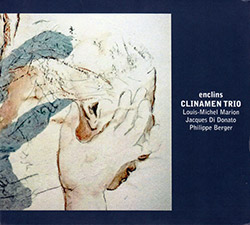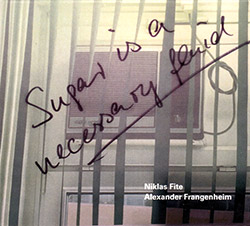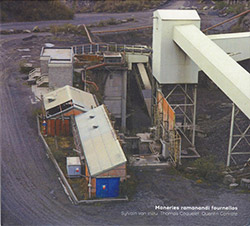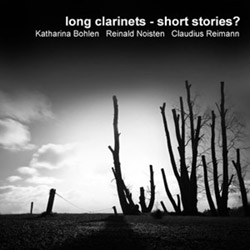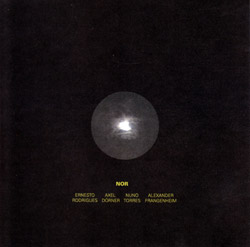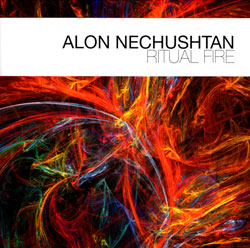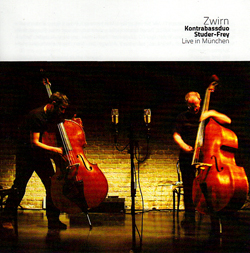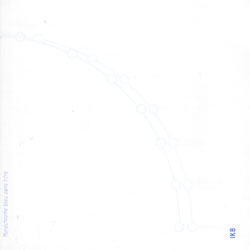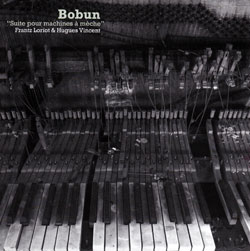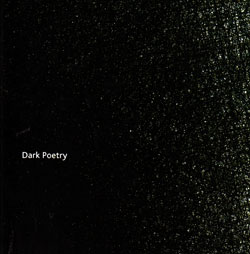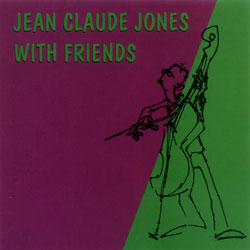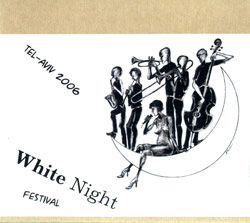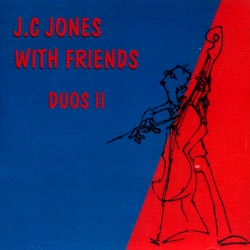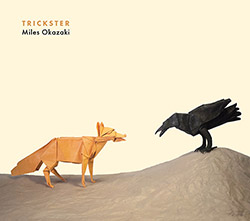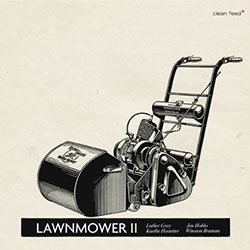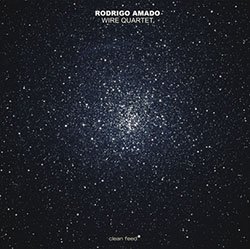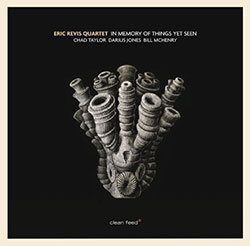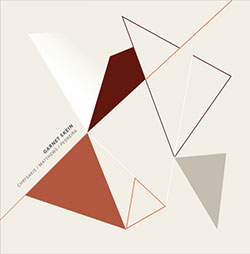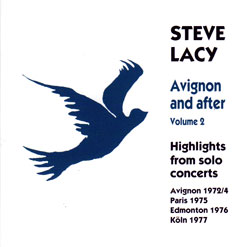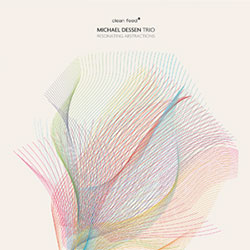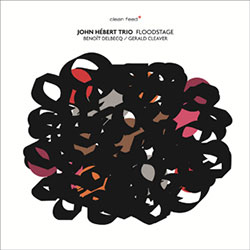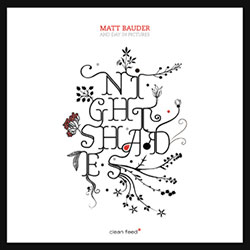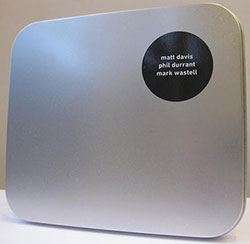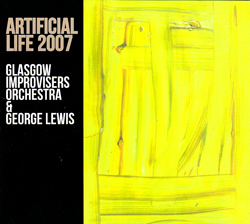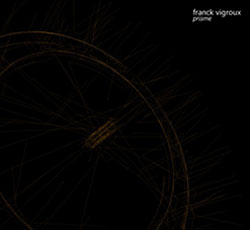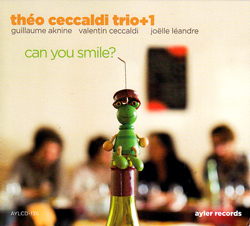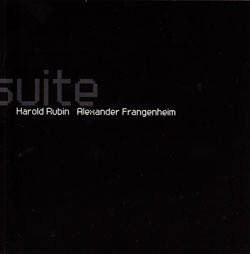
11 short works and a longer "suite" from the duo of Israeli clarinetist Harold Rubin and German bassist Alexander Frangenheim, with electric bassist Mark Smulian making the group a trio on three tracks.
Out of Stock
Quantity in Basket: None
Log In to use our Wish List
Shipping Weight: 3.00 units
Sample The Album:
Harold Rubin-clarinet
Alexander Frangenheim-doublebass
Mark Smulian-electric bass
Click an artist name above to see in-stock items for that artist.
UPC: 5609063402162
Label: Creative Sources
Catalog ID: cs216
Squidco Product Code: 16516
Format: CD
Condition: New
Released: 2012
Country: Portugal
Packaging: Jewel Tray
Recorded in June 2010 at Digihippi Studio, Hod Hasharon by Mark Smulian.
Eleven short works and a longer "suite" from the duo of Israeli clarinetist Harold Rubin and German bassist Alexander Frangenheim, with electric bassist Mark Smulian making the group a trio on three tracks. Recorded in the studio, the dialog between the two ranges from technically powerful, melodically insightful, to oddly idiosyncratic.
Alexander Frangenheim
"Born in Wuppertal, he studied sculpture at the academy of fine arts in Stuttgart and at the same time classical doublebass with Reinald Schwarz, soloist of Stuttgart Philharmonics. Having encountered experimental music in his youth, beside classical playing he soon ventured into free improvisation as well as working with graphic notations in the ensemble of composer Klaus Fessmann, who holds a professorship at Salzburg Mozarteum. After having met Günter Christmann in the early 90s, who became a close friend over the years, a grant offered the possibility to go to London, where he finally was able to explode into a most intense period of sessions, collaborations, concerts and recording sessions, this all with help by John Russell, Chris Burn and John Butcher. Back in Stuttgart he was asked to teach experimental music at the academy of fine arts Stuttgart, which he did for a period of ten years and which led him to extended sound and performance explorations in collaboration with his students. He continued to organize the festival concepts of doing - Interaktion Tanz Musik (1992 - 2003) and, after an intense trip through many european countries meeting dancers for free improvisations and an invitation to the 5th Composers Choreographers Exchange (Southbank Center London), he was co-founding the production center for dance and performance Stuttgart. Being the head of this association for three years and after the festival of concepts of doing 2003, he pushed these structures aside for regaining breath and new freedom and inner engagement in life and arts. At the same time this moment was accompanied by his last days in ensemble zeitkratzer, which he was member of since its beginning in 1997 (performances of famous MMM by and with Lou Reed as well as music by alva noto, Merzbow, Lee Ronaldo, Elliott Sharp, DJ's a.o.).
2005 saw him establishing himself in a space in Berlin to seek new projects. Since then he has recorded three cds, created the music for the experimental film "Lupinen löschen" by Sabine Schöbel, which was shown at the Berlinale 2007, and started to work with analog electronics on the acoustic double bass as well as on an electric one, introducing this to his collaborations with dance."-Creative Sources
Harold Rubin
"Born: Friday 13th May 1932 7.00 am - Breach birth. Sickly child, protected by his mother. Started questioning the wisdom of God at the age of 5 after an incident with his black nanny and convicts working on the road on his way to nursery school. Decided to do something about his frail form at the age of 8 and started to play soccer and to swim.
At the age of 14, became fascinated with the music of Duke Ellington, Count Basie, Barney Bigard and Benny Goodman also Leadbelly and the blues. Started studying clarinet at 16 with Louis Nicholaeff who was a pupil of composition and theory with Rimsky Korsakoff at the Leningrad Conservatory. To the disappointment of his teacher he started to play jazz with high school friends, but still went on playing duets with Nicholaeff.
At the age of 18 played once a week with Dulcie Ryder's group at the Skyline Night Club. At that time Jazz hadn't hit the concert halls and Jazz musicians played for dancers.
He started writing his own music in the fifties and formed his own quartet. Young people followed groups that they could jive and jitterbug to and the quartet had a large following. He speaks about musicians wanting to be regarded as legitimate artists and they started the move into concert halls - sex went out of the jazz experience - no dancing in concert halls - a kind of sterilization. He performed in a concert hall at the first Jazz Festival in Johannesburg. Met the pianist Dave Lee who liked his playing and took him under his wing, which was a great learning experience for Harold. Dave originally from England went back and played with Johnny Dankworth and later with Judy Garland.
Rubin became familiar with the music of Lennie Tristano, Lee Konitz and Warne Marsh which he found stimulating and of course Parker and Gillespie, Monk and later Coltrane, but he never played Bebop although he learned from it. He loved Tony Scott and Eric Dolphy. His quartet included Tony Leveton(piano) Sid Lyndsey(bass) Allan Heyes(drums). They sneaked into the black ghetto Sophiatown and made music with saxophonist Kippy Moeketsi and trombonist Jonas Gwongwa at the Odin Cinema on Sundays. Kippy and Harold became friends, listened to music and played together - each learning from the other.
Studied Architecture at "Wits" University, married in 1957 to Riva Wainer, had 2 sons Adam and Ezra.
After a blasphemy trial related to one of his art works "My Jesus", he was acquitted and left South Africa for Israel in March 1963. He felt impotent in the Apartheid regime.
In Israel he wanted to carry on with original music, but found most jazzists playing Bebop. He played here & there but didn't find musicians who wanted to experiment with him and he stopped playing for almost 12 years. He worked as an architect at the time in the Arieh and Eldar Sharon office where he was involved in design. He was in charge of a project in Nigeria - the Ife University, and traveled very often, enjoying the work.
He met Miriam Kainy in Nigeria in 1973 and fell in love. They moved in together in 74, with Miriam's 2 daughters Yasmine and Shunit. They were both divorced in 75 and married in 76. He started playing clarinet again in late 79. Their daughter Abigail was born in 1980. In 82 he left architecture and started exhibiting his art work in Europe, England and the U.S.A. He taught at The Sadna school of design & architecture for 11 years.
In 84 worked with composer Josi Mar Haim and the group "Season's End." In 1985 he and Mark Smulian (bass) formed the quartet "Zaviot" with Reuben Hoch (drums) and Tommy Belman (guitar). They were very successful in Israel and Germany and performed in festivals and clubs, with original music. They broke up in 89, after a tour with Jimmy Pepper and Christoph Spendel.
Harold became involved in free improvised music and was stimulated by musicians like Cecil Taylor, Michel Portal, Anthony Braxton, the great clarinetist John Carter and later Peter Bronzman and Evan Parker. He started working with young musicians - Kobi Shefi (guitar, bass) Assaf Sirkis (drums) Yuval Messner (cello) Daniel Sarid (piano) Ariel Shibolet (sax) Albert Beger (sax) Dafna Sade (bass) Igal Foni (drums) Reut Regev (trombone) Rafi Malkiel (trombone) Hagai Fershtman (drums) Adam Sheflan (bass) and later with Maya Dunietz (piano) and Yoni Silver (bass clarinet) as well as Ram Gabai (drums) and Shmil Frankel (bass).
He constantly works with Zvi Jaffe and The Tel Aviv Art Ensemble. Jean Claude Jones (bass, live electronics) is an always welcome partner for Harold and he loves making music with Assif Tsahar (saxophone) which he describes as another learning experience.
He talks today of his approach to time and pulse and momentum and uneven pulse and fragmentation and Feel! He wants to make music every time he plays, like it's the first and last time and he tries to come empty and play what he doesn't know.
He won't deny intellect and thought which is there anyhow, but he tries not to make laws for the music. He knows that there is the building up of a musical language all the time and sometimes it is necessary to break down the language and become what he calls "Neanderthal."
He loves the energy and intensity of it all - a growing experience. He maintains that the music keeps him more or less sane and hopes he never loses it.
Harold Rubin as a detached observer."-Harold Rubin Website
Artist Biographies
• Show Bio for Harold Rubin "Harold Rubin (13 May 1932 - 1 April 2020) was a South African-born Israeli artist and free jazz clarinetist. Rubin was born in Johannesburg, South Africa on 13 May 1932. He attended the Jeppe High School for Boys and received private instruction in the fine arts. Instructed in the classical clarinet as a teenager, he developed a fascination with jazz and began playing at the Skyline Night Club at eighteen. Enrolled as an architecture student at the University of the Witwatersrand, he completed his professional studies after further education in London. Rubin's creative endeavours in South African society during the 1950s and 1960s dissented against the apartheid-era Afrikaner establishment by defying the country's racist social norms. Rubin organised his own jazz group in the 1950s, snuck into black townships, and played alongside black musicians. Rubin's visual artwork was first exhibited in 1956. Among Rubin's contributions to the South African fine arts in this spirit was the 1961 Sharpeville, a series of drawings devoted to the brutality of the Apartheid-era authorities during the Sharpeville massacre in 1960. Rubin's most controversial project on the South African art scene of the 1960s was My Jesus, a provocative rendering of the crucifixion in which Jesus Christ appeared as a nude black figure with the head of a monster. The work contained the inscription "I forgive you O Lord, for you know not what you do" - a sardonically reversed "Father forgive them, for they know not what they do" - and depicted the naked figure with a slight hint of an erection. The controversial image was put on display alongside other anti-establishment works at a Johannesburg gallery in 1962. The exhibition caused such furore that the government sent the police to shut down the exhibition and referred its artwork for an examination by its censorship board. Rubin became the second South African to be charged with blasphemy. Acquitted in court of the alleged blasphemy in March 1963, Rubin protested the repressive political environment by leaving the country for Israel. He quickly re-established himself in Tel Aviv, and was employed as an architect in the office of Arieh Sharon, on projects in Israel and abroad. He taught at an academy of architecture and design between the 1960s and his retirement in 1986. Rubin began creating visual art as a critique and commentary on the militaristic aspect of Israeli society as early as the 1960s. The anti-war subject was a prime subject of Rubin's work during the 1980s - a decade witnessing the 1982 invasion of Lebanon and the tensions aroused by the increasingly visible peace movement, and marked by the creation of such works as The Anatomy of a War Widow (1984), a series of twenty-two black-and-white pictures. The caustic Homage to Rabbi Kahane, which portrayed the outspoken ultra-nationalist Rabbi Meir Kahane as a Jewish Nazi, was pulled off the wall by a Knesset member when hung at a Haifa gallery in 1985. The proceeds raised from an August 1987 exhibition and auction of art by Rubin and other Israeli artists at the Meimad Gallery in Tel Aviv were donated to a fund for educational activities and promotion of the values of democracy and freedom of speech dedicated to Emil Grunzweig, an Israeli teacher and Peace Now activist murdered in 1983 by a grenade thrown at a Jerusalem peace rally. Rubin's drawings and paintings have been exhibited in Israel, South Africa, the United States, and Germany since the 1960s. Rubin returned to playing jazz in late 1979, having previously given up performance for more than a decade after his emigration from Africa. He became a founding member of the 1980s Zaviot jazz quartet, which recorded albums with the label Jazzis Records and performed at festivals and clubs in Israel and Europe until its break-up in 1989. Rubin's more recent appearances have included performances with Ariel Shibolet, Assif Tsahar, Daniel Sarid, Maya Dunietz, and Yoni Silver. Awarded the Landau Award in tribute to his contributions to jazz music in 2008, he continued to play jazz with musicians of the younger generations in Tel Aviv. Harold Rubin and his first wife, Riva Wainer, married in 1957, separated in the 1970s and divorced in 1975. Since 1976 he has been married to Miriam Kainy, a well-recognized Israeli dramatist particularly known for plays concerned with the subject of Jewish-Arab relations and feminist themes. His family included two sons from his first marriage, as well as one daughter and two stepdaughters from his second. Rubin was an avowed atheist. He died on 1 April 2020, aged 87." ^ Hide Bio for Harold Rubin • Show Bio for Alexander Frangenheim "Born in Wuppertal, he studied sculpture at the academy of fine arts in Stuttgart and at the same time classical Doublebass with Reinald Schwarz, soloist of Stuttgart Philharmonics. Having encountered experimental music in his youth, beside classical playing he soon ventured into free improvisation as well as working with graphic notations in the ensemble of composer Klaus Fessmann, who holds a professorship at Salzburg Mozarteum. After having met Günter Christmann in the early 90s, who became a close friend over the years, a grant offered the possibility to go to London, where he finally was able to explode into a most intense period of sessions, collaborations, concerts and recording sessions, this all with help by John Russell, Chris Burn and John Butcher. Back in Stuttgart he was asked to teach experimental music at the academy of fine arts Stuttgart, which he did for a period of ten years and which led him to extended sound and performance explorations in collaboration with his students. He continued to organize the festival concepts of doing - Interaktion Tanz Musik (1992 - 2003) and, after an intense trip through many european countries meeting dancers for free improvisations and an invitation to the 5th Composers Choreographers Exchange (Southbank Center London), he was co-founding the production center for dance and performance Stuttgart. Being the head of this association for three years and after the festival of concepts of doing 2003, he pushed these structures aside for regaining breath and new freedom and inner engagement in life and arts. At the same time this moment was accompanied by his last days in ensemble zeitkratzer, which he was member of since its beginning in 1997 (performances of famous MMM by and with Lou Reed as well as music by alva noto, Merzbow, Lee Ronaldo, Elliott Sharp, DJ's a.o.). 2005 saw him establishing himself in a space in Berlin to seek new projects. Since then he has recorded three cds, created the music for the experimental film "Lupinen löschen" by Sabine Schöbel, which was shown at the Berlinale 2007, and started to work with analog electronics on the acoustic double bass as well as on an electric one, introducing this to his collaborations with dance. He played in groups... trio with Jim Denley and Steve Noble; duo with Phil Durrant (cd); quintet with Evan Parker, Phil Wachsman, Thomas Lehn, Roger Turner; duo with Günter Christmann (cd); "Ein Quartett" with Bieler-Wendt, Kolkowski, Zimmerlin; trio with Chris Burn and Axel Dörner. Projects with Günter Christmann: Sextett Vario 34 (cd) und "con moto" (music, dance, sound poetry, film) with David Zambrano, Urs Leimgruber, Fine Kwiatkofski, Elke Schipper (dvd). Concerts with... Paul Lovens, John Butcher, Phil Minton, Derek Bailey, Sven-Ake Johannson, David Moss, John Russell, Johannes Bauer, LeQuan Ninh, Dietmar Diesner, LaDonna Smith, Malcolm Goldstein, Fred Frith, Vinko Globokar, Barry Guy, Torsten Müller, Carlos Zingaro, Fred van Hove, Urs Leimgruber, Mats Gustafsson, Dorothea Schürch, Herb Robertson, Alberto Braida, Michael Griener, Yumiko Tanaka a.o. Intense work with dancers in diverse performing and rehearsing situations. Collaborations with Julyen Hamilton, Vera Mantero, Benoit Lachambre, Ingo Reulecke, Josè Luis Sultàn, Mark Tompkins, Junko Wada, Fine Kwiatkofski, Regina Baumgart, David Zambrano, Sasha Waltz, Katie Duck, Joachim Schlömer, Thomas McManus, Nigel Charnock, Xavier Le Roy, Frans Poelstra, Virpi Pakhinen, Russell Maliphant, Anzu Furukawa, Pal Frenak, Anna Huber, Andreas Müller, Astrid Endruweit, Jennifer Lacey, Lin Yuang Shang. concepts of doing. Between 1992 and 2003 he organized the festival "concepts of doing - Interaktion Tanz Musik" which became an important european plattform for the exchange of the arts inviting many notable artists for free collaborations during 4 days. (Please see: www.concepts-of-doing.de). cd: "screen. Festival concepts of doing 1999" mit Yoshihide, Turner, Leimgruber, Schürch, Parkins, Newton, Frangenheim. Critics: "mikrotonale Edelsteine" (Markus Müller, Jazzthetik), "deliciously subversive" (Cadence), "music straight from the dynamo" (The Wire), "Frangenheim uses extended string techniques Gidon Cremer supplied for Luigi Nono" (The Wire). Lives in Berlin since 2005. In preparation for creative space for 2009, which will allow him to continue his work with dance and other media. Projects: trio with Chris Burn and Axel Dörner; quartet with Thomas Lehn, Le Quan Ninh, Frederic Blondy; duo with Günter Christmann /as well as other formations; trio with Floros Floridis and Ray Kaczynski; cds in prep: quartet with Moss/Bauer/Tanaka, quartet with Turner/Wachsman/Pat Thomas. performance project "streugut" together with Clausen, Reulecke, Rudstrom, Simon." ^ Hide Bio for Alexander Frangenheim
4/22/2024
Have a better biography or biography source? Please Contact Us so that we can update this biography.
4/22/2024
Have a better biography or biography source? Please Contact Us so that we can update this biography.
Track Listing:
1. brughdara jam 3:12
2. clear run 4:01
3. twin leaf 5:24
4. white skies 7:59
5. monkey jam 3:10
6. tintoe 2:12
7. alarm and a fly 3:58
8. slow trio 5:00
9. bass pump walk 3:21
10. commercials (& football never freedom) 4:52
11. wood knocks first 3:02
12. suite 11:54
Improvised Music
European Improv, Free Jazz & Related
Free Improvisation
Creative Sources
Trio Recordings
Search for other titles on the label:
Creative Sources.


